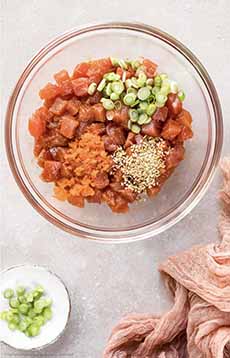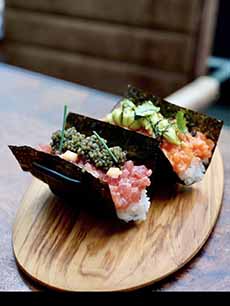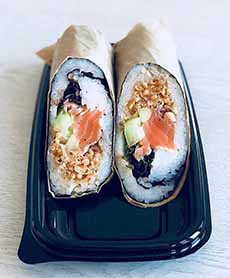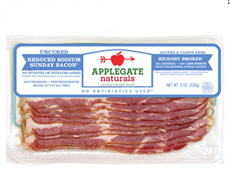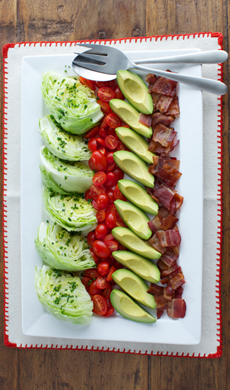|
Given our love of fusion food, we were delighted to discover these sashimi tacos at Haru restaurant in New York City.
You can make them full size or in miniature for appetizers and hors d’oeuvre. At Haru, the sashimi tacos are available in:
Salmon and/or Spicy Salmon
Tuna and/or Spicy Tuna
Yellowtail
Of course, you can make “California roll” tacos with avocado, cucumber, and crab stick or your other favorite sashimi.
We made delicious tacos with bay scallops and seaweed salad. With a standard taco size, some “salad” helps to fill out the base.
If you can’t find seaweed salad, a mix of shredded daikon and carrot is equally delicious; and shredded lettuce always works!
> The history of tacos.
> The history of sushi. The history of sashimi is below.
HOW TO MAKE SASHIMI TACOS
Ingredients
Fish or seafood of choice
Sesame oil
Rice vinegar
Wasabi powder
Soy sauce
Optional filling: shredded carrots and/or daikon, seaweed salad
Taco shells or wonton wrappers
Garnish: snipped chives, thin-sliced green onion (scallion), lemon or lime zest, lemon or lime zest and grated ginger mix, toasted sesame seeds, tobiko (flying fish roe) or salmon caviar
Lime wedges
Preparation
1. BUY sushi-quality fish and dice it into 1/4″ to 1/2″ cubes.
2. MOISTEN/TOSS with sesame oil, rice vinegar, and a bit of wasabi powder. Taste and add soy sauce if the mixture needs a hit of salt. You can also use the spicy tuna recipe in photo #2.
3. PREPARE and fill taco shells. Here’s how Guy Fieri makes shells from wonton wrappers for his tuna taco recipe.
4. GARNISH as desired.
DO YOU KNOW YOUR SASHIMI?
Check out the different types of sashimi in our Sushi & Sashimi Glossary.
THE HISTORY OF SASHIMI
Sashimi is a dish consisting of fresh raw fish or meat (especially beef) sliced into thin pieces and often eaten with soy sauce, wasabi, and gari or shoga (both are pickled ginger—pink-hued shoga is pickled in red plum vinegar and gari, beige in color, is pickled in sweet vinegar).
The word “sashimi” means “pierced body” (sashi = pierced or stuck, mi = body or meat). It dates from the Muromachi period in Japan (1336-1573) and there are different origin stories.
The most colorful one concerns the practice of sticking the fish’s tail and fin to the slices for the purpose of identifying the fish being served.
Sashimi is often the first course in a formal Japanese meal, but it can also be the main course, served with rice and miso soup.
In a multicourse meal, it should be eaten first so that its delicate flavors can be savored before stronger-flavored food affects the palate [source].
Sashimi is sliced thicker than the fish used for sushi, since the latter has more substance served atop or rolled with vinegared rice.
The typical garnish for sashimi is the Asian white radish, daikon, which is shredded into long thin strands, or individual leaves of the herb shiso, a.k.a. perilla (plastic leaves are substituted in lesser establishments).
(If you usually leave the daikon on the plate, you’re missing out on great fiber. You can dip it in soy sauce if you want more flavor. As for shiso leaf: It’s a delicacy that’s also often left behind. A member of the mint family, it tastes a bit like basil. We wrap the leaf around a slice of fish.)
How Old Is Sashimi?
While we know the origin of sashimi, the origin of sashimi is less certain.
In the days before refrigeration, raw fish (for both sashimi and sushi) many fish varieties could only be enjoyed raw along the coastals of Japan. But since Japan consists of hundreds of islands, fresh seafood was available in many locations.
Inhabitants of the interior of the country could have enjoyed lake or river fish.
One origin theory suggests that modern sashimi descends from a dish of thinly sliced raw fish marinated in seasoned rice vinegar called namasu, which was a favorite in Japan during the Heian period (794-1185). The dish is still served today.*
Scholars agree that sashimi became popular in Japan during the Edo period (1600-1867). Nigiri sushi, slices of fish set atop patties of vinegared rice, appeared before the start of the 19th century [source].
In 1965, the landmark Immigration and Nationality Act enabled more Asians to emigrate to the U.S. They brought with them the Asian cuisines we enjoy today. The first sushi restaurant in the U.S. opened in Little Tokyo in Los Angeles in the 1960s.
As sushi has grown in popularity, its preparation has evolved from the traditional to the modern.
From the use of ingredients not native to Japan (avocado for California rolls, cream cheese and smoked salmon for Philadelphia rolls, mango for numerous rolls) to new formats (sushi burritos—photo #5, sushi burgers—photo #6), Japanese sushi has become treasured American fare.
________________
*Namasu is made from raw, thinly sliced vegetables and seafood, marinated in rice vinegar for several hours, which pickles them slightly. Namasu was brought to Japan from China during the Nara period (710-784). Sunomono and other vinegared salads are related to namasu [source].
|


